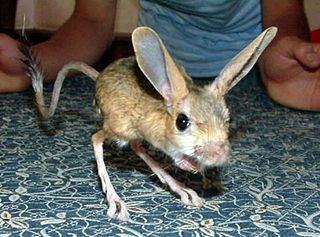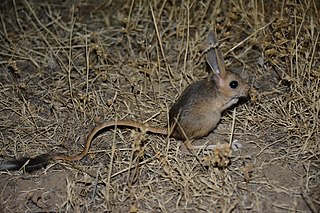
Jerboas are hopping desert rodents found throughout North Africa and Asia, and are members of the family Dipodidae. They tend to live in hot deserts.

The four-toed jerboa is a rodent of the family Dipodidae and genus Scarturus that has four digits. Four-toed jerboas are native to Egypt and Libya. They live in coastal salt marshes and dry deserts.

Dipodoidea is a superfamily of rodents, also known as dipodoids, found across the Northern Hemisphere. This superfamily includes over 50 species among the 16 genera in 3 families. They include the jerboas, jumping mice, and birch mice. Different species are found in grassland, deserts, and forests. They are all capable of saltation, a feature that is most highly evolved in the desert-dwelling jerboas.
The Iranian jerboa is a rodent of the family Dipodidae and subfamily Allactaginae. They are characteristically known as hopping rodents and have only been found in a small population in Iran. Iranian jerboa are microhabitat specialist, they require a particular environment to provide them with specific conditions suitable for living.

The lesser jerboa is a small rodent of Africa and the Middle East. Its diet consists mainly of seeds and grasses.
The Balikun jerboa is a species of rodent in the family Dipodidae. It is found in arid areas of northwestern China and Mongolia. It eats green plants, plant roots, seeds, grasshoppers and beetles.
The Gobi jerboa is a species of rodent in the family Dipodidae. It is found in China and Mongolia. Its natural habitats are temperate grassland and temperate desert.

The small five-toed jerboa is a rodent of the family Dipodidae and genus Scarturus, that has five digits. They are hopping rodents of the rocky deserts in Asia. They have been found in Afghanistan, Armenia, Azerbaijan, China, Georgia, Iran, Kazakhstan, Pakistan, Russia, Tajikistan, Turkey, and Turkmenistan. They have long hind feet, short forelimbs, and walk upright. The jerboa body length ranges from 5–15 cm and has a tail ranging from 7–25 cm. They have large ears in comparison to their body size and a large tail. The tail assists and serves as support when the jerboa is standing upright. These hopping rodents can reach a speed up to 48 km/hr. The forelimbs of the jerboa serve as a pair of hands for feeding, grooming, etc. The male jerboa is usually larger in size and weight in comparison to the female jerboa. The pelt of the jerboa is either silky or velvety in texture and light in color, the coloration helps camouflage into surroundings to avoid predators. "Its coloration varies from sandy or buff to dark russet or black with pale under parts and a white strip on the hip”.
The Euphrates jerboa is a rodent of the family Dipodidae and genus Scarturus. They are characteristically known as hopping rodents. They have been found in Pakistan, Afghanistan, Iran, Iraq, Jordan, Kuwait, Saudi Arabia, Syria, and also occurs very marginally in southeastern Turkey. The Euphrates jerboa's natural habitats are semi-deserts, subtropical or tropical dry lowland grassland and hot deserts.
Hotson's jerboa or the Iranian jerboa, is a species of rodent in the family Dipodidae. It is found in Afghanistan, Iran, and Pakistan.

The great jerboa is a species of rodent in the family Dipodidae. It is found in Kazakhstan, Russia, Turkmenistan, Ukraine and Uzbekistan. It mainly lives in deserts.

The northern three-toed jerboa is a species of rodent in the family Dipodidae. It is the only extant species within the genus Dipus. It ranges across Iran, Uzbekistan, Turkmenistan, Kazakhstan, Russia, China and Mongolia. A common species, the International Union for Conservation of Nature rates it as being of "least concern".

The greater Egyptian jerboa is a species of rodent in the family Dipodidae. It is found in Algeria, Egypt, Libya, Morocco, Saudi Arabia, Tunisia, and is possibly extinct in the Negev Desert of Israel. Its natural habitats are subtropical or tropical dry shrubland, sandy shores, and arable land.
The dwarf fat-tailed jerboa is a species of rodent in the family Dipodidae. It is found in China, Iran, Kazakhstan, Mongolia, and Russia. They mostly reside in desert environments which can explain their size. They go long periods of time without food and water, which means they need a lower metabolic rate, and can be a reason for their size.

The thick-tailed pygmy jerboa is a species of rodent in the family Dipodidae. It is found in China, Kazakhstan, and Mongolia. Its natural habitats are temperate grassland and temperate desert. It is threatened by habitat loss. It is listed by the IUCN as being "least concern".
The Baluchistan pygmy jerboa or dwarf three-toed jerboa, is a species of rodent in the family Dipodidae. It is the only species in the genus Salpingotulus. Adults average only 4.4 cm (1.7 in) in head and body length, with the tail averaging 8 cm (3.1 in). Adult females weigh 3.75 g (0.132 oz). It is currently considered to be endemic to Pakistan. In the 1999 Guinness Book of Records, it was listed as tied for the smallest rodent in the world with the African pygmy mouse.

Allactaginae is a subfamily of rodents.

Williams's jerboa is a species of jerboas native to Afghanistan, Armenia, Azerbaijan, Iran and Turkey.
Paradipodinae is a monotypic subfamily of Dipodidae, consisting solely of the comb-toed jerboa.









